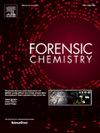A multi-modal spectroscopic approach to forensic discrimination of liquid cosmetic complexion products
IF 2.6
3区 医学
Q2 CHEMISTRY, ANALYTICAL
引用次数: 0
Abstract
Foundations and other complexion products such as concealers or beauty balm creams account for a significant proportion of the global cosmetic market. In addition to being widely used across a range of demographics, these products are inherently transferable through contact and have a variety of distinctive formulations, making them potentially valuable as associative evidence. Despite this, the analysis of complexion products for forensic purposes is a relatively under-researched area, with studies to date largely focussed exclusively on foundation products often analysed using a single technique. In this study, 35 liquid complexion products representing 19 international retailers available within Australia were analysed using ATR-FTIR spectroscopy. Initially indistinguishable samples were then analysed using Raman spectroscopy and X-ray diffraction, which have not previously been applied in the open literature for forensic cosmetic analysis, to enhance discrimination. Chemometric pattern recognition based on infrared data resulted in a discrimination accuracy of 98 % between individual products and classification accuracy of 72 % using a blind validation set. Raman spectroscopy and X-ray diffraction each offered enhanced discrimination of similar products primarily based on mineral content, although similar shades of the same product remain challenging. Analysis of eight duplicate samples purchased from the UK retail market revealed no significant compositional differences between batches from global retailers, which has yet to be explicitly investigated in existing studies. This market survey highlights the chemical variability of complexion products that may be exploited for evidential purposes using a multi-modal analytical workflow.
一种多模态光谱方法用于液体化妆品的法医鉴别
粉底和其他肤色产品,如遮瑕膏或美容乳霜,占全球化妆品市场的很大比例。除了广泛应用于各种人口统计数据之外,这些产品本身具有可通过接触转移的特性,并且具有各种独特的配方,这使得它们作为关联证据具有潜在的价值。尽管如此,用于法医目的的肤色产品分析是一个相对较少的研究领域,迄今为止的研究主要集中在粉底产品上,通常使用单一技术进行分析。在这项研究中,代表澳大利亚19家国际零售商的35种液体肤色产品使用ATR-FTIR光谱进行了分析。最初难以区分的样品,然后使用拉曼光谱和x射线衍射分析,这在以前的公开文献中尚未应用于法医化妆品分析,以增强辨别。基于红外数据的化学计量模式识别在单个产品之间的识别准确率为98%,使用盲验证集的分类准确率为72%。拉曼光谱和x射线衍射都提供了主要基于矿物含量的类似产品的增强辨别,尽管相同产品的相似色调仍然具有挑战性。对从英国零售市场购买的8个重复样品的分析显示,来自全球零售商的批次之间没有显着的成分差异,这尚未在现有研究中明确调查。这项市场调查强调了肤色产品的化学变异性,可以利用多模态分析工作流程用于证据目的。
本文章由计算机程序翻译,如有差异,请以英文原文为准。
求助全文
约1分钟内获得全文
求助全文
来源期刊

Forensic Chemistry
CHEMISTRY, ANALYTICAL-
CiteScore
5.70
自引率
14.80%
发文量
65
审稿时长
46 days
期刊介绍:
Forensic Chemistry publishes high quality manuscripts focusing on the theory, research and application of any chemical science to forensic analysis. The scope of the journal includes fundamental advancements that result in a better understanding of the evidentiary significance derived from the physical and chemical analysis of materials. The scope of Forensic Chemistry will also include the application and or development of any molecular and atomic spectrochemical technique, electrochemical techniques, sensors, surface characterization techniques, mass spectrometry, nuclear magnetic resonance, chemometrics and statistics, and separation sciences (e.g. chromatography) that provide insight into the forensic analysis of materials. Evidential topics of interest to the journal include, but are not limited to, fingerprint analysis, drug analysis, ignitable liquid residue analysis, explosives detection and analysis, the characterization and comparison of trace evidence (glass, fibers, paints and polymers, tapes, soils and other materials), ink and paper analysis, gunshot residue analysis, synthetic pathways for drugs, toxicology and the analysis and chemistry associated with the components of fingermarks. The journal is particularly interested in receiving manuscripts that report advances in the forensic interpretation of chemical evidence. Technology Readiness Level: When submitting an article to Forensic Chemistry, all authors will be asked to self-assign a Technology Readiness Level (TRL) to their article. The purpose of the TRL system is to help readers understand the level of maturity of an idea or method, to help track the evolution of readiness of a given technique or method, and to help filter published articles by the expected ease of implementation in an operation setting within a crime lab.
 求助内容:
求助内容: 应助结果提醒方式:
应助结果提醒方式:


